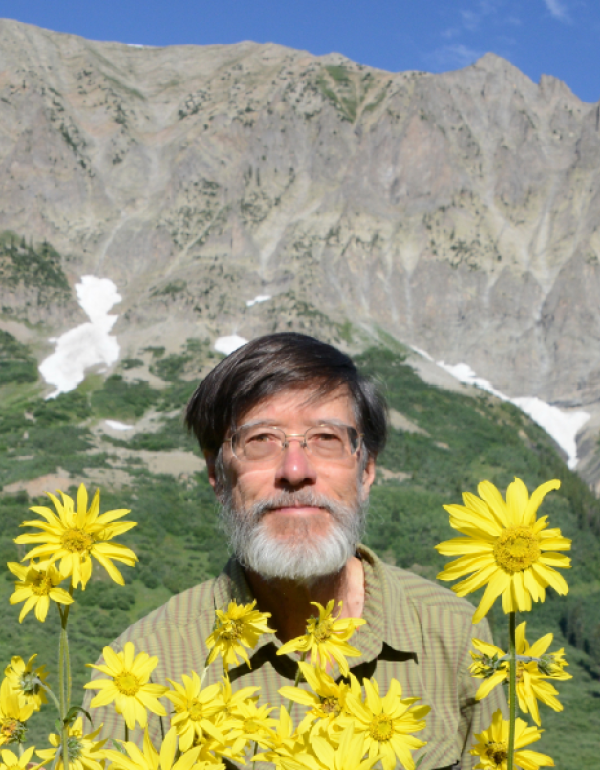
Graduate Program Affiliations
- Marine-Estuarine-Environmental Sciences (MEES)
- BISI-Behavior, Ecology, Evolution, & Systematics (BEES)
Research Interests
Dr. Inouye has worked with bumblebees, euglossine bees, pollinating flies, tephritid flies, hummingbirds, and wildflowers, on topics including pollination biology, flowering phenology, plant demography, and plant-animal interactions such as ant-plant mutualisms, nectar robbing, and seed predation. He has worked in Australia, Austria, Central America, and Colorado, where he has spent summer field seasons since 1971 at the Rocky Mountain Biological Laboratory (RMBL). His long-term studies of flowering phenology and plant demography are supported by the National Science Foundation and are being used now to provide insights into the effects of climate change at high altitudes.
Dr. Inouye taught courses in ecology and conservation biology at the University of Maryland and has also taught at the University of Colorado's Mountain Research Station, the Rocky Mountain Biological Laboratory, and with the Organization for Tropical Studies. He is the founder and moderator for the Ecological Society of America's ECOLOG-L listserv list, and serves on the Board of the North American Pollinator Protection Campaign. He is Past-President of the Ecological Society of America, and a Lead Author on the report on pollinators produced by the Intergovernmental Platform on Biodiversity and Ecosystem Services.
Education
NATO Postdoc, Botanisches Institut, University of Vienna, 1978
Ph.D., University of North Carolina, 1976
B.A., Swarthmore College, 1971
Book Chapters
- Inouye, D. W. In press. Case Study: Climate Change and Frost Effects in Rocky Mountain Plant Communities. Climate Change and Biodiversity, 2nd edition. T. E. Lovejoy and L. Hannah, eds. Yale University Press.
- Inouye, D. W. In press. Climate change in other taxa and links to bird studies. Chapter 20 in: Dunn, Peter, and Anders Møller, Editors. Effects of Climate Change on Birds.
- Inouye, D. W. In press. Effects of climate change on alpine plants and their pollinators. In: The Year in Ecology and Conservation Biology.
- Chapin, F. S. III, S. T.A. Pickett, M. E. Power, S. L. Collins, J. S. Baron, D. W. Inouye, and M. G. Turner. 2015. Earth Stewardship: An Initiative by the Ecological Society of America to Foster Engagement to Sustain Planet Earth. Volume 2, pages 173-194 in: Earth Stewardship. R. Rozzi, F. S. Chapin III, J. B. Callicott et al., Springer International Publishing.Inouye, D. W. 2013. Pollinators, Role of. Encyclopedia of Biodiversity, 2nd edition. S. A. Levin. Waltham, MA, Academic Press. 6: 140-146.
- Wielgolaski, F.-E., and D. W. Inouye. 2013. Phenology of high-latitude climates. In: Phenology: An Integrative Environmental Science (M. D. Schwartz, ed.) Kluwer Academic Publishers. Updated revision for new edition.
- Inouye, D. W., and F.-E. Wielgolaski. 2013. Phenology of high-altitude climates. In: Phenology: An Integrative Environmental Science (M. D. Schwartz, ed.) Kluwer Academic Publishers. Updated revision for new edition.
- Inouye, D W. 2011. Pollinators, the role of (revised). In: Encyclopedia of Biodiversity. Academic Press, San Diego.
- Inouye, D. W. 2011. Reflections: Conservation of Plant-Pollinator Mutualisms. Chapter 21 in: Sammataro, D., and J. A. Yoder, Editors. Honey Bee Colony Health: Challenges and Sustainable Solutions. Taylor & Francis Group.
- Inouye, David and Amy McKinney. 2012. Community Phenology. In Oxford Bibliographies Online: Ecology. Ed. David Gibson. New York: Oxford University Press.
- Inouye, D., and B. Barr. 2006. Consequences of abrupt climate change for hibernating animals and perennial wildflowers at high altitude in the Colorado Rocky Mountains, USA. Pages 166-168 in: Global Change in Mountain Regions (M. F. Price, ed.). Sapiens Publishing, U.K.
- Inouye, D. W. 2005. Biodiversity and ecological security. Pages 203-215 in: From Resource Scarcity to Ecological Security (D. Pirages and K. Cousins, eds.). MIT Press, Cambridge.
- Inouye, D. W., and F.-E. Wielgolaski. 2003. Phenology of high-altitude climates. Pages 195-214 in: Phenology: An Integrative Environmental Science (M. D. Schwartz, ed.) Kluwer Academic Publishers.
- Wielgolaski, F.-E., and D. W. Inouye. 2003. Phenology of high-latitude climates. Pages 175-194 in: Phenology: An Integrative Environmental Science (M. D. Schwartz, ed.) Kluwer Academic Publishers.
- Morales, M., D. W. Inouye, M. L. Leigh and G. Lowe. 2003. Considering interactions: Incorporating biotic interactions into viability assessment. Pages 267-287 in: Population Viability in Plants (C. A. Brigham and M. W. Schwartz, eds.); Ecological Studies, Volume 165. Springer-Verlag, Berlin.
- Inouye, D. W. 2001. Pollinators, the role of. In: Encyclopedia of Biodiversity 4:723-730. Academic Press, San Diego
- Inouye, D. W. 1988. Natural variation in plant and animal populations, and its implications for studies of recovering ecosystems. In: Rehabilitating Damaged Ecosystems (Cairns, J., ed.) pp. 39-50. CRC Press, Boca Raton.
- Inouye, D. W. 1983. The ecology of nectar robbing. In: The Biology of Nectaries (Elias, T. S. and Bentley, B. L., eds.) pp. 153 173. Columbia University Press, NY.
- Inouye, D. W. 1977. Species structure of bumblebee communities in North America and Europe. In: The Role of Arthropods in Forest Ecosystems (Mattson, W. J., ed.) pp. 35 40. Springer-Verlag, NY.
Book
- Kearns, C. A. and Inouye, D. W. 1993. Techniques for Pollination Biologists. University Press of Colorado, Niwot, CO. 583 pages. 2nd printing 1994. 3rd printing 2000.







